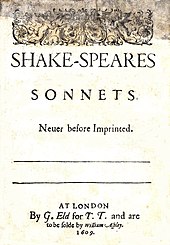In 1593 and 1594, when the theatres were closed because of
plague, Shakespeare published two narrative poems on erotic themes,
Venus and Adonis and
The Rape of Lucrece. He dedicated them to
Henry Wriothesley, Earl of Southampton. In
Venus and Adonis, an innocent
Adonis rejects the sexual advances of
Venus; while in
The Rape of Lucrece, the virtuous wife
Lucrece is raped by the lustful
Tarquin.
[118] Influenced by
Ovid's Metamorphoses,
[119] the poems show the guilt and moral confusion that result from uncontrolled lust.
[120] Both proved popular and were often reprinted during Shakespeare's lifetime. A third narrative poem,
A Lover's Complaint, in which a young woman laments her seduction by a persuasive suitor, was printed in the first edition of the
Sonnets in 1609. Most scholars now accept that Shakespeare wrote
A Lover's Complaint. Critics consider that its fine qualities are marred by leaden effects.
[121] The Phoenix and the Turtle, printed in Robert Chester's 1601
Love's Martyr, mourns the deaths of the legendary
phoenix and his lover, the faithful
turtle dove. In 1599, two early drafts of sonnets 138 and 144 appeared in
The Passionate Pilgrim, published under Shakespeare's name but without his permission.
[122]
Sonnets

Title page from 1609 edition of
Shake-Speares Sonnets.
Published in 1609, the
Sonnets were the last of Shakespeare's non-dramatic works to be printed. Scholars are not certain when each of the 154 sonnets was composed, but evidence suggests that Shakespeare wrote sonnets throughout his career for a private readership.
[123] Even before the two unauthorised sonnets appeared in
The Passionate Pilgrim in 1599,
Francis Meres had referred in 1598 to Shakespeare's "sugred Sonnets among his private friends".
[124] Few analysts believe that the published collection follows Shakespeare's intended sequence.
[125] He seems to have planned two contrasting series: one about uncontrollable lust for a married woman of dark complexion (the "dark lady"), and one about conflicted love for a fair young man (the "fair youth"). It remains unclear if these figures represent real individuals, or if the authorial "I" who addresses them represents Shakespeare himself, though
Wordsworth believed that with the sonnets "Shakespeare unlocked his heart".
[126] The 1609 edition was dedicated to a "Mr. W.H.", credited as "the only begetter" of the poems. It is not known whether this was written by Shakespeare himself or by the publisher,
Thomas Thorpe, whose initials appear at the foot of the dedication page; nor is it known who Mr. W.H. was, despite numerous theories, or whether Shakespeare even authorised the publication.
[127] Critics praise the
Sonnets as a profound meditation on the nature of love, sexual passion, procreation, death, and time.
[128]
"Shall I compare thee to a summer's day?
Thou art more lovely and more temperate..."
|
| Lines from Shakespeare's Sonnet 18.[129] |
The production of Shakespeare's sonnets was in some way influenced by the
Italian sonnet: it was popularised by
Dante and
Petrarch and refined in
Spain and
France by
DuBellay and
Ronsard.
[130] Shakespeare probably had access to these last two authors, and read English poets as
Richard Field and John Davies.
[130] The French and Italian poets gave preference to the Italian form of sonnet—two groups of four lines, or
quatrains (always rhymed a-b-b-a-b-b-a) followed by two groups of three lines, or
tercets (variously rhymed c-c-d e-e-d or c-c-d e-d-e)—which created a sonorous music in the
vowel rich
Romance languages, but in Shakespeare it is artificial and monotonous for the
English language. To overcome this problem derived from the difference of language, Shakespeare chose to follow the idiomatic rhyme scheme used by
Philip Sidney in his
Astrophel and Stella (published posthumously in 1591), where the rhymes are interlaced in two pairs of couplets to make the
quatrain.
[130]

0 comments:
Post a Comment